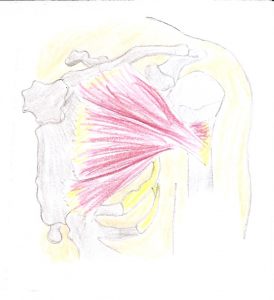
The major muscle in the chest, pectoralis major, it’s a broad muscle in the shape of a fan, with one on each side of the rib cage. Although 1 muscle, it tends to be divided into 3 segments, namely: clavicular, sternal and costal (check the image to the left to see the different directions of the muscle fibre segments). The different directions of the muscle fibers – differentiated into upper and lower fibres – allow the pectoralis major to perform different and sometimes opposing actions (ie flexion and extension). This means that the pectoralis can act as an antagonist to itself.
Muscles work in pairs. When 1 is working (agonist), it’s paired muscle works in opposition (antagonist). In effect, whilst 1 muscle may be contracting, it’s paired muscle is relaxing. Flexion and extension are 2 movements that are directly opposite. Move your straight arm forward (flexion) and now move it backwards (extension) – the swinging movement of your arm as you walk – and you can feel your pectoralis major muscle involved in both actions.
Where is it?
Origin: Medial half of the clavicle, sternum and the cartilage of the 1-6 ribs.
Insertion: Crest of the greater tubercle of humerus
What does it do?
All fibers adduct and medially rotate the shoulder. They also help to elevate the thorax during inhalation.
The upper fibers (clavicular) flex and horizontally adduct the shoulder
The sternocostal segment obliquely adducts the arm towards the opposite hip
The lower fibers extend the shoulder.
Sports that rely heavily on the pectoralis major include golf; gymnastics; ie rings and bar; racket sports, ie tennis; rock or wall climbing.
Common injuries and problems
The actions of the pectoralis major mean that any problems with arm or shoulder movement will impact on the functionality of the muscle. Stress and pain in other shoulder muscles (rotator cuffs and rhomboids) will likely result in both raised and medially rotated (inward rotation) shoulders as a protective response. This means that the pectoralis major muscles can become chronically contracted leading to anterior shoulder pain.
When the pectoralis major has to deal with heavy loads, it’s muscle fibers can tear. Complete tears can be caused by strength work – weight lifting or other athletics sports such as javelin, shot-putting – that is beyond the muscles capabilities. It is the muscle’s tendon at the humerus (arm) that is more likely to be damaged.
Recovery will include range of motion (ROM) exercises and a sling may be required for 2-4 weeks. Strength exercises should not be undertaken until at least 4-6 weeks after the injury and should only be carried out gradually. It is recommended that you seek professional advice. Complete tears mean that a return to sport may be possible after 3-5 months.
Stretches for pectoralis major
Self stretches for the pectoralis that can be done either against a wall or whilst sitting (making it a good option when working at a desk).
Stand side-ways to a wall with one arm bent and your hand resting flat against it. Now gradually rotate away from the wall with your body, whilst keeping your hand in place so that you can feel the stretch across the pectoral muscles. Hold for 20-30 seconds before returning to the starting position. Repeat on both sides.
In a sitting position, hook one arm behind the back rest of the chair and then rotate your body away from the arm to feel the same stretch (again for 20-30 seconds). This is a good stretch to try when taking a break from office work and your computer.
8 August 2016
